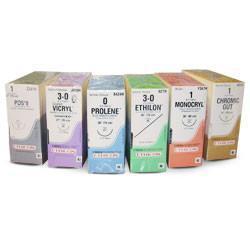Sutures are typically used to close all types of wounds, whether they’re surface level or deep. In order to close a profound wound, the surgeon may be required to stitch two edges of the skin together layer by layer, which would involve placing and leaving sutures underneath the skin. There are two types of Ethicon sutures that are used to close wounds and here is some information about each.
Non-Absorbable – These types of stitches are often used when the cut is very visible, as they decrease the appearance of scarring. These stitches need to be removed after the repaired area has healed, which typically takes about seven days. If the stitches are not removed at the correct time, either too early or too late, they are much more likely to leave a permanent, visible scar.
Doctors also use non-absorbable stitches for more complex internal lesions that require a longer healing time (and where appearance doesn't matter). Although they are called non-absorbable, there are some varieties that deteriorate very slowly, meaning that they will hold until an internal laceration has fully healed and no further invasive procedures will be necessary. The patient just waits for them to eventually break down.
Absorbable – Absorbable sutures are used for lesions that will heal quickly. These types of sutures are typically made of material that naturally dissolves on its own, some of which are synthetics and others of which are made from animal intestines (often cow or sheep). The amazing thing about absorbable stitches is that when the doctor first puts them in, they are incredibly strong and become weaker and weaker over a period of a couple of weeks. These sutures take about a full two months to completely dissolve.
There are some risks involved with all medical procedures involving stitches. There is always some chance that there will be permanent scarring from the sutures. A bulging scar (keloid) can occur after stitching, which will cause the area to become uncomfortable and itchy and could lead to some cosmetic issues for the person who has it. Additionally, there may be some tension in the skin of the sutured area, making it less flexible than the surrounding skin and causing discomfort.
Many surgeons choose Ethicon sutures because they are strong and reliable, and are the best prevention people have against the above complications -- that and a good surgeon. The procedure is a common one, but has many differing levels of severity and complexity (some people slice their fingers, while others need sutures after a C-section). No matter what the case, however, every patient needs careful attention and the best products available. It is important for people to speak to a physician before any procedure (or after, in the case of emergency care) to know what to expect and how to properly care for a sutured area.
Sources


